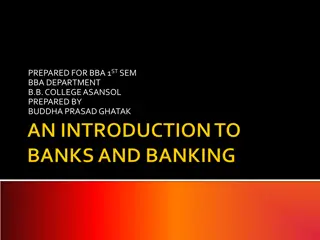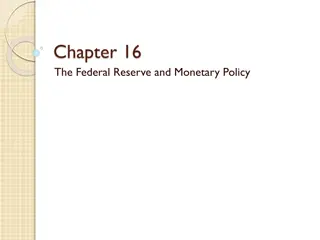Overview of Reserve Bank of India Functions and Responsibilities
The Reserve Bank of India serves as the central bank in India, responsible for functions such as issuing bank notes, acting as banker to the government, and serving as the banker's bank. It manages currency chests, handles government finances, and ensures the stability and soundness of the banking system. The bank plays a crucial role in maintaining monetary stability and facilitating economic development in the country.
Download Presentation

Please find below an Image/Link to download the presentation.
The content on the website is provided AS IS for your information and personal use only. It may not be sold, licensed, or shared on other websites without obtaining consent from the author.If you encounter any issues during the download, it is possible that the publisher has removed the file from their server.
You are allowed to download the files provided on this website for personal or commercial use, subject to the condition that they are used lawfully. All files are the property of their respective owners.
The content on the website is provided AS IS for your information and personal use only. It may not be sold, licensed, or shared on other websites without obtaining consent from the author.
E N D
Presentation Transcript
Functions of Reserve Bank of India 1. Reserve Bank as Note-Issuing Authority One Rupee notes and coins were issued by the Government of India Bank Notes were issued by RBI RBI has the sole right to issue bank notes in India. Issue of Notes and general banking business is undertaken by two departments : Issue Department Banking Department
The assets of the Issue Department against bank notes are as follows:- o Gold Coins and Bullion o Foreign Securities o Rupee coins o Government of India rupee securities o Bill of Exchange and Promissory Notes
Currency Chests It is the boxes or containers in which stocks of new or re issuable notes are stored along with rupee coins. It is maintained by RBI, State Bank and its subsidiaries, public sector banks, Government treasuries. Advantages: Payment of the bank exceed, immediately withdraw funds Funds are surplus, deposit the amount in it to. Exchange of rupee coins for notes Issue of new notes for old and soiled ones
2. Reserve Bank as Banker to Government It act as banker to the central and state governments. Issue of new loans on behalf of Government Auctions for the treasury bills and government dated securities Appoint SBI as its sole agent Act as adviser to the government on important economic and financial matters
3. Reserve Bank as Bankers Bank It is the banker to all banks included in scheduled banks. It must be:- A state co-operative bank A company registered under Companies Act 1956 An Institution notified by Central Government A corporation incorporated outside India
Minimum value of paid-up capital and Reserves Not less than 5 lakhs Total realizable value of the assets minus outside liabilities equal to or more than 5 lakh rupees. Depositors Interests Soundness Solvency Interest of the depositors
4. Reserve Bank as Lender of the Last Resort a) Rediscounting of Bills Commercial Bills Drawn and payable only in India and mature within 90 days Bill for Financing Agricultural operations Marketing of crops and mature within 15 months Bill for Financing Cottage and Small- Scale Industries Mature within 12 months Bill for Holding or Trading in Government Securities - Mature within 90 days Foreign Bills Export of goods from India and mature within 180 days
b) Loans and Advances Grant loans and advances to the scheduled banks repayable on demand or on the expiry of fixed period not exceeding 90 days against the security of the following: Stock, and Securities Gold or Silver Bill of exchange and promissory notes
5. Emergency Advances To purchase or sell any bill of exchange or promissory notes To make loans and advances and not exceeding 90 days
6. As a Controller of Credit a) Cash Reserve Ratio(CRR) (4%) Certain percentage of the total bank deposits has to be kept in the current account with RBI. Bank can t lend the money to corporates or individuals. Banks don t earn anything on that.
b) Statutory Liquidity Ratio(SLR) (19.5%) It is the amount of money that is invested in certain specified securities of central and state government. c) Selective Credit Control purpose of advances Margins to be maintained Maximum amount of advances Rate of Interest
d) Bank Rate Policy - Bank rate (6.75%) is the rate charged by the RBI for funds to commercial banks e) Liquidity Adjustment facility Repo rate(6.25%) It is the rate at which the RBI lends money to commercial banks in the event of any shortfalls of funds. Reverse repo rate(6%) It is the rate of interest offered by RBI on loan taken by it for a short period from the banks.
7. Undertake transactions in foreign exchange under FEMA(Foreign Exchange Management Act 1999). RBI holds India s reserves of international currencies and administers the exchange control system in the country.
8. Collection and Furnishing of credit information power to collect credit information from banks along with the prescribed fee.























